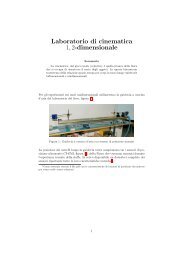Newton's law of cooling revisited - Cartan
Newton's law of cooling revisited - Cartan
Newton's law of cooling revisited - Cartan
Create successful ePaper yourself
Turn your PDF publications into a flip-book with our unique Google optimized e-Paper software.
1070 M Vollmer<br />
(4) The temperature <strong>of</strong> the surrounding stays constant during the <strong>cooling</strong> proceeds, this means<br />
that the surroundings must be a very large thermal reservoir.<br />
(5) The only internal energy source <strong>of</strong> the object is the stored thermal energy.<br />
It is quite easy to experimentally fulfil requirements (1), (4) and (5). The convective heat<br />
transfer (3) assumption is more critical. In experiments it can be kept constant using steady<br />
airflow around objects, i.e. for forced convection. If experiments use free convection, αC may<br />
depend on the temperature difference. In the following theoretical analysis, we will however<br />
focus on the influence <strong>of</strong> the linearization <strong>of</strong> the radiative heat transfer. In particular, we will<br />
discuss the question, whether the linearization <strong>of</strong> equation (3) (to give equation (5)) does also<br />
work over extended temperature ranges.<br />
5. Modelling with the correct radiative heat transfer and arbitrary temperature<br />
differences for the <strong>cooling</strong> <strong>of</strong> objects for Bi ≪ 1<br />
The <strong>cooling</strong> <strong>of</strong> objects can be studied by theoretical modelling using the complete nonlinear<br />
heat transfer.<br />
mc dTobj<br />
dt =−αCon · A · (Tobj − Tsurr) − ε · σ · A · � T 4 � 4<br />
obj − Tsurr . (10)<br />
Equation (10) was numerically solved for a specific example <strong>of</strong> painted aluminium cubes <strong>of</strong><br />
40 mm size since such cubes were used in one <strong>of</strong> the experiments. They may serve as a<br />
theoretical model system with simple geometry.<br />
The <strong>cooling</strong>, as described by equation (10), depends on three parameters, first the<br />
cube size (in general this relates to the energy storage capability <strong>of</strong> the object), second the<br />
convective heat-transfer coefficient and third the emissivity <strong>of</strong> the object, i.e. the contribution<br />
<strong>of</strong> the radiative heat transfer. Figure 3 depicts the results while varying these parameters<br />
independently in semi logarithmic plots. Newton’s <strong>law</strong> would be represented with a straight<br />
line.<br />
The variation <strong>of</strong> cube size (a) in particular the variation <strong>of</strong> the slope <strong>of</strong> the plots directly<br />
relates to the fact that the time constant for <strong>cooling</strong> is linearly proportional to size. The other<br />
parameters for convection and emissivity lead to curved <strong>cooling</strong> plots, i.e. deviations from<br />
the simple exponential behaviour (straight line) for all investigated sizes. The variation <strong>of</strong><br />
the convective heat-transfer coefficient (b) does have a strong impact on the linearity <strong>of</strong> the<br />
plot. The larger αconv, the more the plot follows a straight line. Similarly, the variation <strong>of</strong><br />
emissivity (c) shows that very small emissivities (e.g. ε




